![]()
![]()
![]()
Use LEFT and RIGHT arrow keys to navigate between flashcards;
Use UP and DOWN arrow keys to flip the card;
H to show hint;
A reads text to speech;
195 Cards in this Set
- Front
- Back
|
Salivation starts at |
3 months |
|
|
Development of both sets of teeth begin in |
Utero |
|
|
Children have 20 deciduous teeth(temp) that erupt between the ages of |
6 and 24 months of age |
|
|
When should all 20 teeth appear by |
2 1/2 |
|
|
Deciduous teeth lost at age ... through ...... |
6 - 12 |
|
|
Nasal stuffiness and epistaxis May occur during pregnancy as a result of |
Increased vascularity in the upper respiratory tract |
|
|
Bifid uvula |
A condition in which the uvula is split either completely or partially |
|
|
Which significant group does the bifid uvula occur in and at what percentage? |
10% in American Indian groups |
|
|
What is torus palatinus? |
A bony ridge running in the middle of hard palate seen in 20% to 35% of the population |
|
|
What do Bronchial breath sounds sound like? |
High pitch, loud amplitude, expiration > inspiration, harsh and hollow quality. |
|
|
Where are the bronchial sounds located? |
Trachea and larynx |
|
|
Vesicular sounds |
Moderate pitch and amplitude, inspiration = expiration, mixed quality. |
|
|
Where to find vesicular sounds |
Over the major bronchi where few aleveoli is located. |
|
|
Where are the bronchiole vesicular sounds heard in infants and children? |
Heard in the peripheral lung fields until age 5 |
|
|
As the newborn cries (vocals) the nurse should check for ? |
Tactile fremitus |
|
|
What is the rule of thumb for chest circumference of a new born baby? |
The chest circumference should be 2cm less than the head until age 2 |
|
|
What is the Appgar scoring system used for? |
Assessed successful extrauterine(life outside uterus) the) life |
|
|
When is the Appgar scoring system? |
Used in a newborn at 1 and 5 minutes after birth. |
|
|
Which factor influences a harsh sound in the bronchiole vesicular space in a child |
Thin chest |
|
|
What are the sounds expected to hear when auscultating an infants chest |
Fine crackles which normal because of the opening of their airway |
|
|
What are some changes that occur in the air space of a pregnant woman? |
Costal margins widen by 50% Deep respirations 40% increase of tidal volume |
|
|
How does the airway change in an elder |
Get tired easily from deep mouth inspirations, may feel dizzy, therefore let them hold their breath for a few minutes. |
|
|
What are the expected changes with sharing with thorax adventitious sounds? |
Chest cage increase in AP diameter Round barrel chest due to Kyohosis Prominent bony ridges Chest expansion decrease but still symmetrical Costal cartilage become calcified=less mobile thorax. |
|
|
At what age does a child thorax reach an adults ratio of 1:2? |
Age 6 |
|
|
Atlectasis |
Collapsed, sunken section of alveoli due to airway obstruction, compression of the lung, or lack of surfactant |
|
|
What is the Appgar scoring system used for? |
Assessed successful extrauterine(life outside uterus) life |
|
|
When is the Appgar scoring system used? |
Used in a newborn at 1 and 5 minutes after birth. |
|
|
How does the Appgar scoring system work? |
Scale of 0 - 10 The higher the number = the better the baby is doin(needing only suction of nose and mouth and routine care) |
|
|
J |
F |
|
|
True or False: New borns use obligate nose breathers |
True |
|
|
What do you see in a newborn that signifies that the intercostal muscles are not well developed? |
Abdomen bulge but little thoracic expansion |
|
|
What do you see in a newborn that signifies that the intercostal muscles are not well developed? |
Abdomen bulge but little thoracic expansion |
|
|
What is the normal respiratory rate for new borns? |
30 to 40 bpm - 60bpm |
|
|
What do you see in a newborn that signifies that the intercostal muscles are not well developed? |
Abdomen bulge but little thoracic expansion |
|
|
What is the normal respiratory rate for new borns? |
30 to 40 bpm - 60bpm |
|
|
How many seconds is a brief apnea in a newborn? |
10 - 15 second normal |
|
|
What do you see in a newborn that signifies that the intercostal muscles are not well developed? |
Abdomen bulge but little thoracic expansion |
|
|
What is the normal respiratory rate for new borns? |
30 to 40 bpm - 60bpm |
|
|
How many seconds is a brief apnea in a newborn? |
10 - 15 second normal |
|
|
True or false: Always count the respiratory rate for a full minute in a newborn |
True |
|
|
What do you see in a newborn that signifies that the intercostal muscles are not well developed? |
Abdomen bulge but little thoracic expansion |
|
|
What is the normal respiratory rate for new borns? |
30 to 40 bpm - 60bpm |
|
|
How many seconds is a brief apnea in a newborn? |
10 - 15 second normal |
|
|
True or false: Always count the respiratory rate for a full minute in a newborn |
True |
|
|
How to palpate a newborn to assess respiratory? |
Use both hands to encircle thorax to observe for lumps, mass, or crepitus. |
|
|
What do you see in a newborn that signifies that the intercostal muscles are not well developed? |
Abdomen bulge but little thoracic expansion |
|
|
What is the normal respiratory rate for new borns? |
30 to 40 bpm - 60bpm |
|
|
How many seconds is a brief apnea in a newborn? |
10 - 15 second normal |
|
|
True or false: Always count the respiratory rate for a full minute in a newborn |
True |
|
|
How to palpate a newborn to assess respiratory? |
Use both hands to encircle thorax to observe for lumps, mass, or crepitus. |
|
|
True or false: may feel costochondral junctions in normal infants. |
True |
|
|
Percussion sound on Tumor is |
A dull note, soft muffled thud |
|
|
Percussion sound of fluid |
Visceral |
|
|
Percussion of sound when there is air present |
Resonance (ex: over the lung field) |
|
|
Percussion sound when there is too much air |
Hyperresonance |
|
|
What is a pneumothorax? |
Free air in pleural space causes partial or complete lung collapse. |
|
|
3 facts about Pneumothorax |
Lung collapse Unilaterally (in one side) Air in pleural space neutralizes the negative pressure present resulting in lung collapse. Can be spontaneous, traumatic, or tension. |
|
|
When inspecting for pneumothorax in Respiratory assessment what should you look for? |
Chest expansion whether it be equal or unequal. |
|
|
What should you assess for when palpating for someone you suspect of having asthma |
Tactile fremitus |
|
|
When inspecting for pneumonia |
Check for increased respiration rates |
|
|
What should you palpate for in pneumonia suspected patient |
Chest expansion decreased in affected side |
|
|
Percussion on pneumonia suspected person |
Dull over lobar area of pneumonia. However normally it should be resonant |
|
|
What is crepitus |
Is a coarse crackling sensation palpable over the skin surface. Occurs in subcutaneous emphysema as after open thoracic injury or surgery |
|
|
How do we inspect the lungs/thorax |
Thoracic cage Respirations Skin color and condition Persons position Facial expression Level of consciousness |
|
|
How to palpate lungs/thorax |
symmetric expansion Tactile fremitus |
|
|
How to percussion lungs/thorax |
Percussion over all lung fields |
|
|
How to auscultation lungs/thorax |
Asses normal breath sounds boring any abnormal breath sounds |
|
|
What is bronchophony |
Asking the person to repeat 99 and listen to over the chest wall |
|
|
What should you do when palpating for Pneumothorax during respiratory assessment? |
Decreases or absent Tactile fremitus |
|
|
Which diseases present a symptom of wheezing |
Asthma, lung cancer, heart failure, chronic pulmonary embolism, expiratory wheezing occurs with with lower airway obstruction. |
|
|
What are atelectatic crackles |
When sections of alveoli are not fully aerated (as in sleepers or in older adults) they deflate slightly and accumulate secretions |
|
|
What do atelectatic crackles sound like? |
Short, popping, crackling sounds that last only a few breaths. |
|
|
Resonance |
Over normal lung fields when percussed |
|
|
Hyper resonance |
Too much air present |
|
|
Why would someone have unequal chest expansion |
Atelectaasis , pneumonia |
|
|
How do we asses unequal chest expansion? |
Place warmed hand on the posterolateral chest with thumbs at the level of T9 or T10. Slide hands medically and pinch up a small fold of skin between your thumbs. Make patient take deep breath and thumbs should move apart symmetrically
|
|
|
Subjection data for pulmonary embolism |
Chest pain, worse on deep inspiration, dyspnea |
|
|
What would be findings on inspection of pulmonary embolism patient |
Apprehensive, restless, anxiety, mental status changes, cyanosis, tachypnea, cough, hemoptysis, PaO2<80% on pulse oximetry, respiratory alkalosis. |
|
|
What is found in palpating in pulmonary embolism patient? |
Diaphoresis(sweating), hypotension, |
|
|
What is Bronchitis |
Proliferation of mucus glands in the passageways, resulting in excess mucus secretion inflammation of bronchi with partial obstruction by secretions or construction. Deflated alveoli beyond obstruction and bronchial inflammation/copious secretions. |
|
|
What is heard when auscultating patient with pulmonary embolism |
Tachycardia Accentuated pulmonic component of heart sound S2 Crackles Wheezes |
|
|
Pleuritis |
Pain with breathing and it disappears within a few days if pleural fluid accumulated and separates pleurae |
|
|
Which general assessment/exam helps to determine whether oral lesions are infectious, traumatic, immunologic, or malignant etiology |
Conducting a History exam |
|
|
When should a lesion be investigated? |
When it has been present for more than 2 weeks |
|
|
Where do we look for lesions in the mouth |
Lips Tongue Buccal mucosa
|
|
|
How to inspect for bronchitis in resp assessment |
Look for .. Rasping cough Thick mucous sputum |
|
|
How to palpate for bronchitis |
Tactile fremitus |
|
|
What is does pleural friction sound like? |
A very superficial sound that is coarse and low pitched.. when close to the eat sounds like crackles. |
|
|
What causes pleural friction |
When pleural becomes inflamed and lose their normal lubricating fluid; their opposing roughened pleural spaces rub together during respiration, heard best in anterolacteral wall where against lung mobility exists. |
|
|
What is asthma |
Allergic hypersensitivity to certain inhaled allergens irritants that produces inflammation, bronchospasm, edema in the bronchioles, and secretion of highly vicious mucus. |
|
|
How to inspect for asthma in resp assessment? |
SOB with audible wheezing Use of accessory muscles Expiration prolonged expiration |
|
|
What to look for in percussion that signifies asthma in resp assessment |
Resonant |
|
|
When inspecting for pneumothorax in Respiratory assessment what should you look for? |
Chest expansion whether it be equal or unequal. |
|
|
What should you assess for when palpating for someone you suspect of having asthma |
Tactile fremitus |
|
|
When inspecting for pneumonia |
Check for increased respiration rates |
|
|
What should you palpate for in pneumonia suspected patient |
Chest expansion decreased in affected side |
|
|
Percussion on pneumonia suspected person |
Dull over lobar area of pneumonia. However normally it should be resonant |
|
|
What is crepitus |
Is a coarse crackling sensation palpable over the skin surface. Occurs in subcutaneous emphysema as after open thoracic injury or surgery |
|
|
How do we inspect the lungs/thorax |
Thoracic cage Respirations Skin color and condition Persons position Facial expression Level of consciousness |
|
|
How to palpate lungs/thorax |
symmetric expansion Tactile fremitus |
|
|
How to percussion lungs/thorax |
Percussion over all lung fields |
|
|
How to auscultation lungs/thorax |
Asses normal breath sounds boring any abnormal breath sounds |
|
|
What is bronchophony |
Asking the person to repeat 99 and listen to over the chest wall |
|
|
What should you do when palpating for Pneumothorax during respiratory assessment? |
Decreases or absent Tactile fremitus |
|
|
Which diseases present a symptom of wheezing |
Asthma, lung cancer, heart failure, chronic pulmonary embolism, expiratory wheezing occurs with with lower airway obstruction. |
|
|
What are atelectatic crackles |
When sections of alveoli are not fully aerated (as in sleepers or in older adults) they deflate slightly and accumulate secretions |
|
|
What do atelectatic crackles sound like? |
Short, popping, crackling sounds that last only a few breaths. |
|
|
Resonance |
Over normal lung fields when percussed |
|
|
Hyper resonance |
Too much air present |
|
|
Why would someone have unequal chest expansion |
Atelectaasis , pneumonia |
|
|
How do we asses unequal chest expansion? |
Place warmed hand on the posterolateral chest with thumbs at the level of T9 or T10. Slide hands medically and pinch up a small fold of skin between your thumbs. Make patient take deep breath and thumbs should move apart symmetrically
|
|
|
Subjection data for pulmonary embolism |
Chest pain, worse on deep inspiration, dyspnea |
|
|
What would be findings on inspection of pulmonary embolism patient |
Apprehensive, restless, anxiety, mental status changes, cyanosis, tachypnea, cough, hemoptysis, PaO2<80% on pulse oximetry, respiratory alkalosis. |
|
|
What is found in palpating in pulmonary embolism patient? |
Diaphoresis(sweating), hypotension, |
|
|
What is Bronchitis |
Proliferation of mucus glands in the passageways, resulting in excess mucus secretion inflammation of bronchi with partial obstruction by secretions or construction. Deflated alveoli beyond obstruction and bronchial inflammation/copious secretions. |
|
|
What is heard when auscultating patient with pulmonary embolism |
Tachycardia Accentuated pulmonic component of heart sound S2 Crackles Wheezes |
|
|
Pleuritis |
Pain with breathing and it disappears within a few days if pleural fluid accumulated and separates pleurae |
|
|
Which general assessment/exam helps to determine whether oral lesions are infectious, traumatic, immunologic, or malignant etiology |
Conducting a History exam |
|
|
When should a lesion be investigated? |
When it has been present for more than 2 weeks |
|
|
Where do we look for lesions in the mouth |
Lips Tongue Buccal mucosa
|
|
|
Where are tonsils located in the mouth |
Behind anterior tonsillitis pillar |
|
|
How to inspect for bronchitis in resp assessment |
Look for .. Rasping cough Thick mucous sputum |
|
|
How to palpate for bronchitis |
Tactile fremitus |
|
|
What is does pleural friction sound like? |
A very superficial sound that is coarse and low pitched.. when close to the eat sounds like crackles. |
|
|
What causes pleural friction |
When pleural becomes inflamed and lose their normal lubricating fluid; their opposing roughened pleural spaces rub together during respiration, heard best in anterolacteral wall where against lung mobility exists. |
|
|
What is asthma |
Allergic hypersensitivity to certain inhaled allergens irritants that produces inflammation, bronchospasm, edema in the bronchioles, and secretion of highly vicious mucus. |
|
|
How to inspect for asthma in resp assessment? |
SOB with audible wheezing Use of accessory muscles Expiration prolonged expiration |
|
|
What to look for in percussion that signifies asthma in resp assessment |
Resonant |
|
|
When do tonsillitis tissues enlarge? |
During childhood until puberty and then involuted. The posterior pharyngeal wall is behind these structures Some small blood vessels may show on it |
|
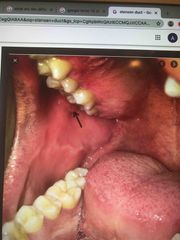
Stensen (Parotid) duct |
Route that saliva takes from the major salivary gland Runs forward to open the buccal mucosa opposite the second molar. |
|
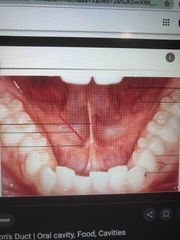
Wharton (submandibullar) duct |
Runs up and forward to the floor of the mouth and opens at either side of the frenulum |
|

Paranasal sinus |
Air pockets within the cranium They lighten the weight of the skulls bones, serve as resonators for sound production, and provide mucus |
|
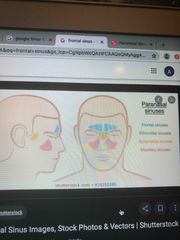
Frontal sinus |
Above orbits |
|
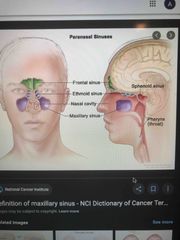
Maxillary sinus |
In the maxilla (cheeks) along the sides of the nasal cavity |
|
|
Paranasal sinus |
Air pockets within the cranium They lighten the weight of the skulls bones, serve as resonators for sound production, and provide mucus |
|
|
Frontal sinus |
Above orbits |
|
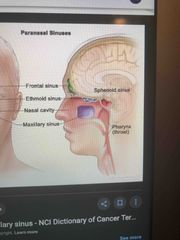
Sphenoid sinuses |
Deep within the skull in the sphenoid bone |
|
|
When does the maxillary sinus reach full size? |
When all permanent teeth have erupted |
|
|
Ethmoid sinus |
Sinuses between the orbits |
|
|
Sphenoid sinuses |
Deep within the skull in the sphenoid bone |
|
|
Which sinuses are we born with? |
Maxillary sinus and Ethmoid sinus |
|
|
3 facts to know about Frontal sinus |
Absent at birth Full development at 7-8 Reaches full size after puberty |
|
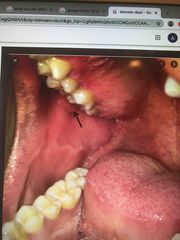
Stensen (Parotid) duct |
Route that saliva takes from the major salivary gland Runs forward to open the buccal mucosa opposite the second molar. |
|
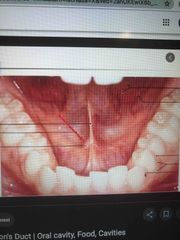
Wharton (submandibullar) duct |
Runs up and forward to the floor of the mouth and opens at either side of the frenulum |
|
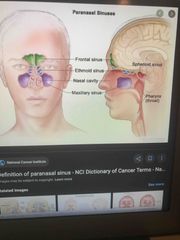
Paranasal sinus |
Air pockets within the cranium They lighten the weight of the skulls bones, serve as resonators for sound production, and provide mucus |
|
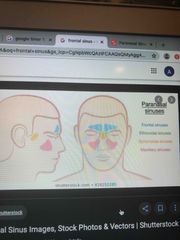
Frontal sinus |
Above orbits |
|
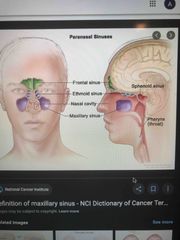
Maxillary sinus |
In the maxilla (cheeks) along the sides of the nasal cavity |
|
|
Wharton (submandibullar) duct |
Runs up and forward to the floor of the mouth and opens at either side of the frenulum |
|
|
Paranasal sinus |
Air pockets within the cranium They lighten the weight of the skulls bones, serve as resonators for sound production, and provide mucus |
|
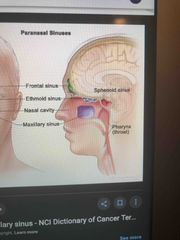
Sphenoid sinuses |
Deep within the skull in the sphenoid bone |
|
|
Maxillary sinus |
In the maxilla (cheeks) along the sides of the nasal cavity |
|
|
When does the maxillary sinus reach full size? |
When all permanent teeth have erupted |
|
|
Ethmoid sinus |
Sinuses between the orbits |
|
|
Sphenoid sinuses |
Deep within the skull in the sphenoid bone |
|
|
Which sinuses are we born with? |
Maxillary sinus and Ethmoid sinus |
|
|
3 facts to know about Frontal sinus |
Absent at birth Full development at 7-8 Reaches full size after puberty |
|
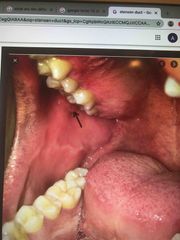
Stensen (Parotid) duct |
Route that saliva takes from the major salivary gland Runs forward to open the buccal mucosa opposite the second molar. |
|
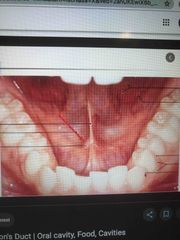
Wharton (submandibullar) duct |
Runs up and forward to the floor of the mouth and opens at either side of the frenulum |
|
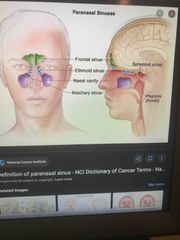
Paranasal sinus |
Air pockets within the cranium They lighten the weight of the skulls bones, serve as resonators for sound production, and provide mucus |
|
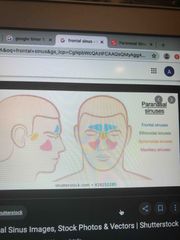
Frontal sinus |
Above orbits |
|

Maxillary sinus |
In the maxilla (cheeks) along the sides of the nasal cavity |
|
|
What is Leukoderma? |
A benign, milky, bluish-white, opaque appearance of the buccal mucosa that occurs commonly in African Americans. |
|
|
Wharton (submandibullar) duct |
Runs up and forward to the floor of the mouth and opens at either side of the frenulum |
|
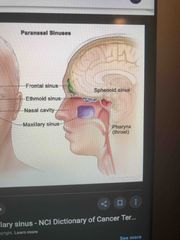
Sphenoid sinuses |
Deep within the skull in the sphenoid bone |
|
|
Frontal sinus |
Above orbits |
|
|
Maxillary sinus |
In the maxilla (cheeks) along the sides of the nasal cavity |
|
|
When does the maxillary sinus reach full size? |
When all permanent teeth have erupted |
|
|
Ethmoid sinus |
Sinuses between the orbits |
|
|
Sphenoid sinuses |
Deep within the skull in the sphenoid bone |
|
|
Which sinuses are we born with? |
Maxillary sinus and Ethmoid sinus |
|
|
3 facts to know about Frontal sinus |
Absent at birth Full development at 7-8 Reaches full size after puberty |
|
|
How to assess nose (SNMDSdT) |
Symmetry, no deformity, or skin lesions Nares patent Mucosa pink No discharge, lesions, or polyps No septal deviation No tenderness to palpation on sinus |
|
|
How to assess mouth (CMAT) |
Can clench teeth Mucosa and gingival pink, no masses or lesions Teeth all present, straight, and in good repair Tongue should be smooth, pink, no lesions, protrudes in midline, no tremor |
|
|
How to assess throat (MUT) |
Mucosa pink, no lesions, or exudate Uvula rises midline on phonation Tonsils out |
|
|
What is Leukoderma? |
A benign, milky, bluish-white opaque appearance of the buccal mucosa that occurs commonly in African Americans. |
|

What is Leukoplakia |
Chalky white, thick, raised patch with well-defined boarders. The lesion is firmly attached and does not scrape off. (Associated with squamous carcinoma) It may occur on the lateral edges of the tongue. It is caused by chronic irritation of smoking and alcohol use. Lesions are precancerous; must refer to specialist. |
|
|
What is a torus platinums? |
A benign bony ridge running in the middle of the hard palate. It occurs in 20 - 35% of U.S population. |
|
|
True or false: Torus platinus is more common in females |
True |
|
|
True or false: Bifid uvula occurs in 2% of the general population and 10% in American Indian group |
True |
|
|
True or false: Bifid uvula occurs in 2% of the general population and 10% in American Indian group |
True |
|
|
Joplin spots are a early prodromal (warning) sign of |
Measles |
|
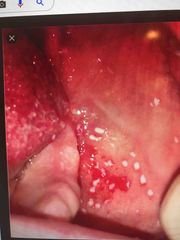
What do Koplik spots look like? |
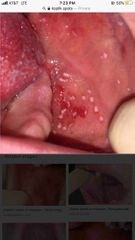
Small blue-white spots with irregular red halo scattered over mucosa opposite the molars. |
|

Aphthous ulcers |
Common “Canker sore” is a vesicle at first and then a small, round, “punched out” ulcer with a white base surrounded by a red halo. It is painful and lasts for 1 - 2 weeks. (Unknown cause but associated with stress, fatigue, and food allergy) |
|
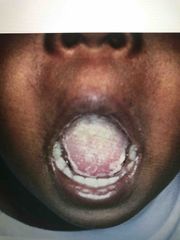
Candidiasis |
AKA Monilial infection; A white, cheesy, curd like patch on the buccal mucosa and tongue. It scrapes off leaving a raw red surface that bleeds easily. Termed trust in newborn It is an opportunistic infection that occurs after the use of antibiotics and corticosteroids and immunosuppressive people. |
|
|
What is the name of the sucking area on the newborns lip? |
Sucking tubercle |
|
|
Describe the sucking tubercle |
A small pad in the middle of the upper lip from friction of breastfeeding or bottle-feeding |
|
|
Findings in assessment for Tonsillitis (ECWG) |
Exudate on tonsils Color: Bright red and swollen and may have exudate or large white spots. White membrane covering the tonsils (may accompany infectious mononucleosis, leukemia, diphtheria. Grade 1+ visible 2+ halfway between tonsillitis pillars and uvula 3+ touching the uvula 4+ touching one another |
|
|
What is an early sign of AIDS |
Oral Kaposi sarcoma |
|
|
Sign of HIV/AIDS seen in oral assessment |
Candidiasis Candida species as normal oral flora is present in 60% of healthy adults. |
|
|
Overgrowth of Candida occurs with |
Steroid inhaler use HIV infection use of broad spectrum antibiotics or corticosteroids leukemia malnutrition or reduced immunity. |
|
|
B |
H |
|
|
Deciduous teeth are replaced with permanent teeth starting with |
Central incisors |
|
|
Permanent teeth appear earlier in girls or boys? |
Girls |
|
|
True or false: permanent teeth erupt earlier in black or white children? |
Black |
|
|
Method for calculating the number of deciduous teeth in children younger than 2 years. |
(X - 6) The child’s age in months minus 6 = expected number of deciduous teeth. |

